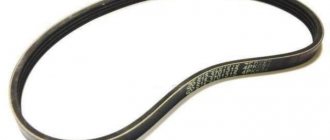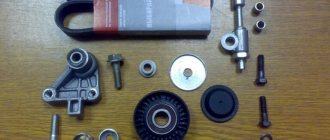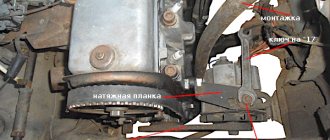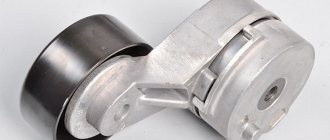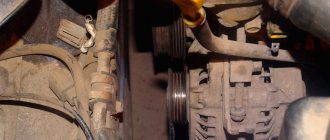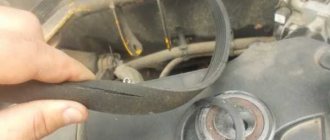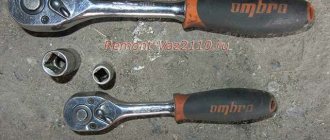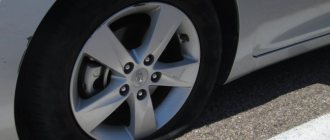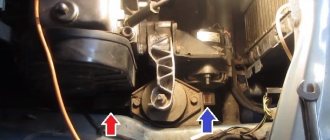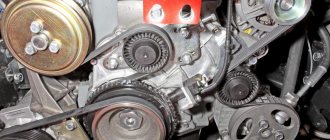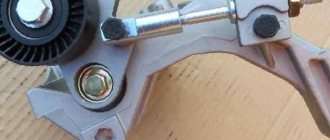Extending the life of the alternator belt
So, in order for the alternator belt to last a long time, you need to take care of it. Carefully check for debris and dirt in the belt tracks. Check the tension of the alternator belt promptly and carefully. A properly tensioned alternator belt should rotate 90 degrees. A too-tightened alternator belt will quickly become unusable and lead to a series of breakdowns. The consequences of a tightened belt can be sad. This is mainly the failure of the bearings of the generator, pump, air conditioning clutch and power steering. If the alternator belt is not tightened, the belt may squeak when the headlights or air conditioning are turned on, that is, when a load appears on the belt, it will slip along the pulley, which will quickly render it unusable. It is advisable to buy belts from trusted manufacturers and only ones suitable for a car of a specific brand. It is not recommended to install used belts.
General questions about working with the Grant generator
Let's consider general questions: everything except replacement.
Tension check
There are two approaches: visual assessment and physical.
Visual assessment of condition:
- the car is on a flat surface, the gear is in neutral, the handbrake is off, the hood is open;
- We don’t start the car - we put it in 5th gear;
- We opened the hood and found a generator: we push the car back, resting against the bumper;
- We inspect the required part along its entire length: are there any breaks or cracks? It needs to be changed.
Physical assessment:
- if you have a tool that measures pressure force: press the belt with a force of 10 kg*s - the deflection should be no more than 10 mm;
- there is no special tool: we try to turn it across - it should turn no more than 90 degrees.
How to tighten the alternator belt on a Grant
This section applies only to machines with a tensioner. No - change the part or see above how to install it.
Subsequence:
- we use ring wrenches 8, 19;
- Throw key 19 onto the lead screw;
- wrench 8 for locknut;
- we touch;
- Now you can turn the lead screw: clockwise to loosen, counterclockwise to tighten;
- got the desired result - tighten the locknut.
When to change: technical regulations for replacing a VAZ 2190 belt
AvtoVAZ requires checking the condition of this part every 15,000 kilometers.
Replacement is required every 30,000 kilometers, regardless of condition.
How to remove a generator on a Grant
It needs to be removed for repairs, replacement of bearings or rollers.
The step-by-step process involves:
- remove the negative terminal from the battery;
- working with the generator: disconnect the wiring harness from it;
- remove the cover of the power wire nut, remove the nut and remove the wire from the bolt;
- unscrew and pull out the upper and lower fastening bolts - to work with the lower one, you may need to climb into a hole, throw off the tin protection of the internal combustion engine and dismantle it from below;
- move the part to the right mudguard, remove the belt, and remove it.
You can do without a hole. Example:
Reasons why the alternator belt breaks
There are a huge number of reasons why the alternator belt breaks. It is not always possible to predict a broken alternator belt. Therefore, you should carefully monitor the technical condition of the car.
Aging
The main reason for a broken alternator belt is aging. During its service life, the belt experiences enormous loads, from mechanical to thermal. Over time, the elasticity of the belt is lost; it becomes rougher and more fragile; cracks appear, resulting in breakage.
Old belt with cracks
Seized bearings
Another very common problem with a broken generator belt is jamming of the bearings of the mechanisms that drive the generator belt. For example, such as a generator, pump, air conditioning compressor, power steering, etc. To prevent the belt from breaking for this reason, you should listen to the operation of the engine and, if noise appears, eliminate the cause of the noise.
Broken alternator belt
Foreign objects getting under the belt
While driving on the roads, you can often notice various debris or something similar on the road. All this can cause the generator belt to break. Quite often there are cases when stones or sticks get under the generator belt, as a result of which the belt experiences overvoltage and breaks. The same can happen if the car is driven through deep snow, water or mud. In order to avoid such a set of circumstances, it is not recommended to drive without protective boots and generator casings.
Pulleys and Alignment
So, why do belts break? Experts say one of the main reasons is that the pulley is installed crookedly. Lack of mutual alignment leads to the fact that the belt rotates incorrectly, touches various mechanisms with its sides, and quickly wears out.
It happens that the pulley on the power steering pump is placed backwards, incorrectly. Again, no alignment. The pulley is rearranged, the problem disappears.
Crankshaft pulley
It doesn’t hurt to always check another pulley – the crank pulley – for runout. Lack of mutual alignment can also occur due to a crooked crank shaft pulley.
To check the runout, just use a dial indicator.
It is also recommended to check the runout on the generator itself and on its tensioner. Such diagnostics will help determine whether there is a distortion.
A simple inspection of the pulleys is the first thing a caring car owner does. First of all, it is determined whether they are coaxial to each other. This is done like this: if the belt is pulled straight with a string, then the pulleys are in the same plane.
Attention. For V-belts, skew is allowed, but not more than 1 mm per 100 mm.
Alignment is an important thing. Checking it is the first step! It happens that not only the pulleys, but also the units themselves are crooked. For example, a non-original pump may be installed on a car. You check it and see that the difference in size from the hub to the base is very large.
It happens that pulleys come across prefabricated ones. That is, they are made from two halves using spot welding. When the belt is tensioned, the welding may fail and fall off. The tension will push the pulley halves apart, the belt will begin to fall into the resulting gap and tear.
The pulley may also not be original. That is, with a smaller diameter. In this case, a large load will appear on the generator, the belt will begin to slip, and accordingly, its sides will wear out.
It is, of course, better to replace such a pulley, but there are craftsmen who add washers, etc. This technique can achieve alignment, however, not always. You straighten one element, and then you notice that the power steering has gone out of plane or something else.
For reference:
- Pulleys from VAZs are not suitable for many cars due to the smaller diameter of the mounting hole;
- GAZ vehicles often have different planes of rotation, although the diameter may be the same.
Another reason is burrs on the pulley plane. They greatly wear out the rubber material of the belt and can create a step on the product, thereby shortening the service life and causing a break. In some cases, due to burrs, it is not possible to drive even a week with a new belt.
Mutual alignment
Burrs are nodules in the form of metal points that rise above the plane of the pulley. It is clear that this is not acceptable. You should go over them with a file, sand them, in a word. After this, the belt will serve its life, at least for at least 1 year (active operation of the machine).
Finally, the pulley itself may be too stiff. For example, this is observed on old domestic cars. You install new belts, but they are not designed for such metal - Soviet steel, stamped and non-separable design. It is better to replace such a pulley with a solid one made of some light alloy.
It is noteworthy that if the alignment is incorrect, the battery does not hold a charge for a long time, because the belt twists. That is, the gene no longer produces the required voltage, since it is not functioning correctly. All this can be determined by the battery, which quickly runs out.
So, the first reason why a belt can break is problems with the pulley and lack of alignment. Pulleys are often installed incorrectly; they may have differences in plane, burrs, etc. The pulleys themselves may not be original, prefabricated, or too hard.
What to do when the alternator belt breaks on the road
The first thing you should do is not panic, because there is a way out of any situation. If you are in the city or not far from an auto parts store. You can get to the store without an alternator belt, but you first need to assess the situation.
Some vehicles use an alternator belt drive to rotate the coolant circulation pump. Therefore, if on your car the coolant circulation pump is driven by the alternator belt drive, then driving without an alternator belt on such a car is strictly PROHIBITED . If you start driving such a car, the engine will inevitably overheat and fail.
The engine on which the alternator belt rotates the coolant pump
If the pump on the car is rotated by the timing belt drive, then you can safely continue driving on the battery. For a longer trip, you must turn off all electrical equipment of the car, i.e. turn off the headlights (if you are driving at night, you can turn off one right headlight and continue driving with one headlight, this will save battery power), the interior heater, music, etc. On a well-charged battery, you can travel up to 50 km.
Tools at hand instead of a belt
The alternator belt can be replaced with improvised means that are found in every car and used as a belt.
Handy tools that can be used to replace the alternator belt:
- nylon tights
- tape or tape
- rope
- lumbar belt
Rope instead of generator belt
In order to replace the alternator belt with improvised means, you do not need any special skills in car repair.
Nylon tights and tape are wound on the pulleys where the generator belt should be and tied into a knot; you can drive on such a belt of tights or tape for up to 100 km, after which a break is inevitable. All these items can be used to get to the nearest auto parts store or service station where your car will be restored to good condition.
